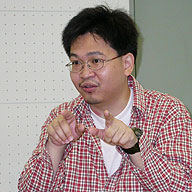An Interview with Lam Kin-hung
I Wanted to Try an Approach Different from All Other Works

Q: Why did you decide to make this piece?
LK: While I was studying at California Institute of the Arts, I was making a film but didn’t have enough funds and needed to figure out how to shoot economically. I thought it would be good to take a nimble approach and do the whole thing myself, so I needed to set it up so I could do everything on my own, from scriptwriting and directing to production. I asked myself over and over how could I make something interesting in those circumstances, and the first thing that came to mind was the city of Hong Kong. It’s the place where I was born, a place where feelings of love and hate mingle. I don’t feel pride but I can’t hate the place. And previously I’d worked as an instructor in Hong Kong teaching physically disabled people things like drawing and reading, and since I had a point of contact with them I thought of relating them with Hong Kong.
Q: Why did you have people with physical disabilities speak?
LK: Hong Kong has around seven million people, and over ten percent are said to have physical disabilities. They are living without receiving social security from the government. Before studying film in the U.S., I worked as a photojournalist in Hong Kong. Through this work, I started wondering exactly how disabled people like them look at the world, and at the same time I wanted to use some method to depict them. Before and after going to the U.S. I saw a lot of films dealing with disabled people, but I wanted to try an approach different from any of the other films.
Q: Why did you crop off the landscape with a still camera, exactly like a photograph?
LK: If you’re trying to grasp how physically disabled people see the world, you do things like follow them with a camera and shoot them talking. But if I move the camera like that, my own subjectivity enters the picture. In order to grasp them in the most objective way possible I selected the simple method of keeping the camera stationary. For the ending, I shot all the different landscapes from different angles. This expresses that people all have their own way of looking at things.
Q: What does the title The Circle’s Corner mean?
LK: Try drawing a circle with a pencil. On the line of the circle, there aren’t any points that form corners. Only a smooth curved line continues. If you try imagining people standing there, I think you’ll understand that when it comes to a circle, you can’t say that people are at any particular place. Though the place that the three people who appear are talking about is indeed Hong Kong, they never utter the word “Hong Kong.” But we can grasp an image of Hong Kong from what they say. Viewers freely get a feeling of a specific place through the image presented. Conversely, it’s also possible to think there are countless corners in a circle. I wasn’t trying to show the particular place of Hong Kong or specific people who have disabilities. Rather, I wanted to express that landscapes and people resembling them and ourselves exist in all places.
(Compiled by Kotani Mayo)
Interviewers: Kotani Mayo / Interpreter: Saito Shinko
Photography: Sato Akari / Video: Kato Takanobu / 2003-10-13
